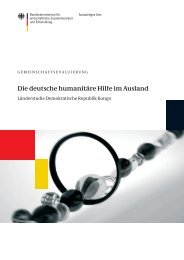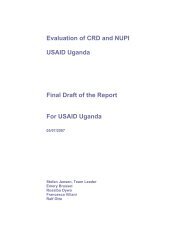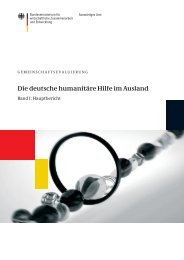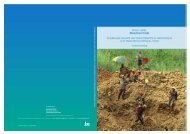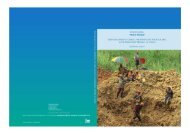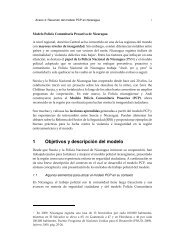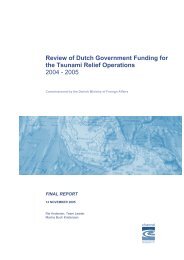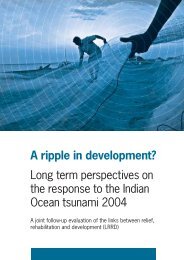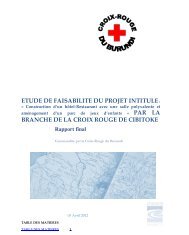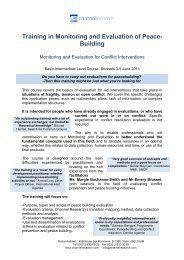German Humanitarian Aid Abroad - Channel Research
German Humanitarian Aid Abroad - Channel Research
German Humanitarian Aid Abroad - Channel Research
You also want an ePaper? Increase the reach of your titles
YUMPU automatically turns print PDFs into web optimized ePapers that Google loves.
the Congo and the Central African Republic. As a result of the improved security in Northern<br />
Uganda, by January 2010 around 1.4 million of the 1.8 million IDPs had returned to their<br />
home areas from camps in northern Uganda’s West Nile, Acholi and Lango sub-regions; over<br />
400,000 returned in 2009 alone.<br />
This trend continued in 2010 with growing confidence in the stability of the absence of<br />
violence and very favourable rains across Northern Uganda. During project visits in Lango<br />
sub-region, the evaluation team found the return process well on its way. Despite strong<br />
disincentives to return such as lack of water, health, and education infrastructure, there<br />
seems to be confidence in a better life outside of the camps, back in the former home<br />
villages. The official closure of all IDP camps in the central and western parts of Northern<br />
Uganda is foreseen for the second half of 2010.<br />
As of June 2010, there are 295,000 IDPs in Northern Uganda (people in camps and people<br />
in transit sites) 24 (see Annex 10 for recent IDP figures). This compares to 437,000 IDPs in<br />
December 2009 and 710,000 IDPs in February 2009 (and 869,000 IDPs in November 2008<br />
and 915,000 IDPs in October 2008). The remainder of the 1.8 million people who were<br />
displaced by the conflict in northern Uganda have now returned to their home areas. Many of<br />
these returnees have ongoing protection and assistance needs.<br />
The situation in 2010 still presents areas of serious concern. Many of the IDPs remaining in<br />
camps are extremely vulnerable individuals (EVIs), i.e., elderly, disabled, and sick people,<br />
including people living with HIV/AIDS. IDPs who had returned to their villages of origin still<br />
face significant challenges, and the sustainability of their life in the re-settled villages is by no<br />
25<br />
means guaranteed. As available documents and discussions with many resource persons<br />
during the evaluation indicate, the obstacles they face fall into four broad categories:<br />
• The absence or inadequacy of basic services (clean water, sanitation, health care<br />
and education). Schools in return areas continued to struggle with a lack of teachers,<br />
classrooms, teachers’ housing, latrines, and water access points. The number of<br />
pupils per classroom and teachers remained well above national standards.<br />
• The limited opportunities to rebuild (economic) livelihoods are a serious threat to the<br />
sustainability of return. Insufficient economic and physical access to seed and<br />
fertiliser combined with poor weather monitoring and forecasting resulted in a 2009<br />
harvest that was only half of what was expected. A food crisis arose across the north<br />
due to the premature termination of general food assistance. In 2010, exceptionally<br />
good rains and humanitarian agricultural interventions will lead to a bumper harvest,<br />
partly restoring the resilience of resettled former IDPs to withstand the next drought.<br />
• Disputes over land in return areas, and the weakness of mechanisms to resolve<br />
them, exacerbated the vulnerability of returnees, including in particular widows, single<br />
mothers, orphans, and former child soldiers.<br />
• With the end of IDP camps and the departure of most international humanitarian<br />
actors, very resource-poor families that re-start their lives in remote villages<br />
‘disappear’ from the humanitarian radar. In effect and during the first two to four<br />
24 These figures do not include IDPs in Karamoja or IDPs in urban areas outside the Acholi, Lango,<br />
Teso and West Nile regions.<br />
25 E.g., UN OCHA Consolidated Appeal 2010 and its mid-year revision (June 2010)<br />
11



